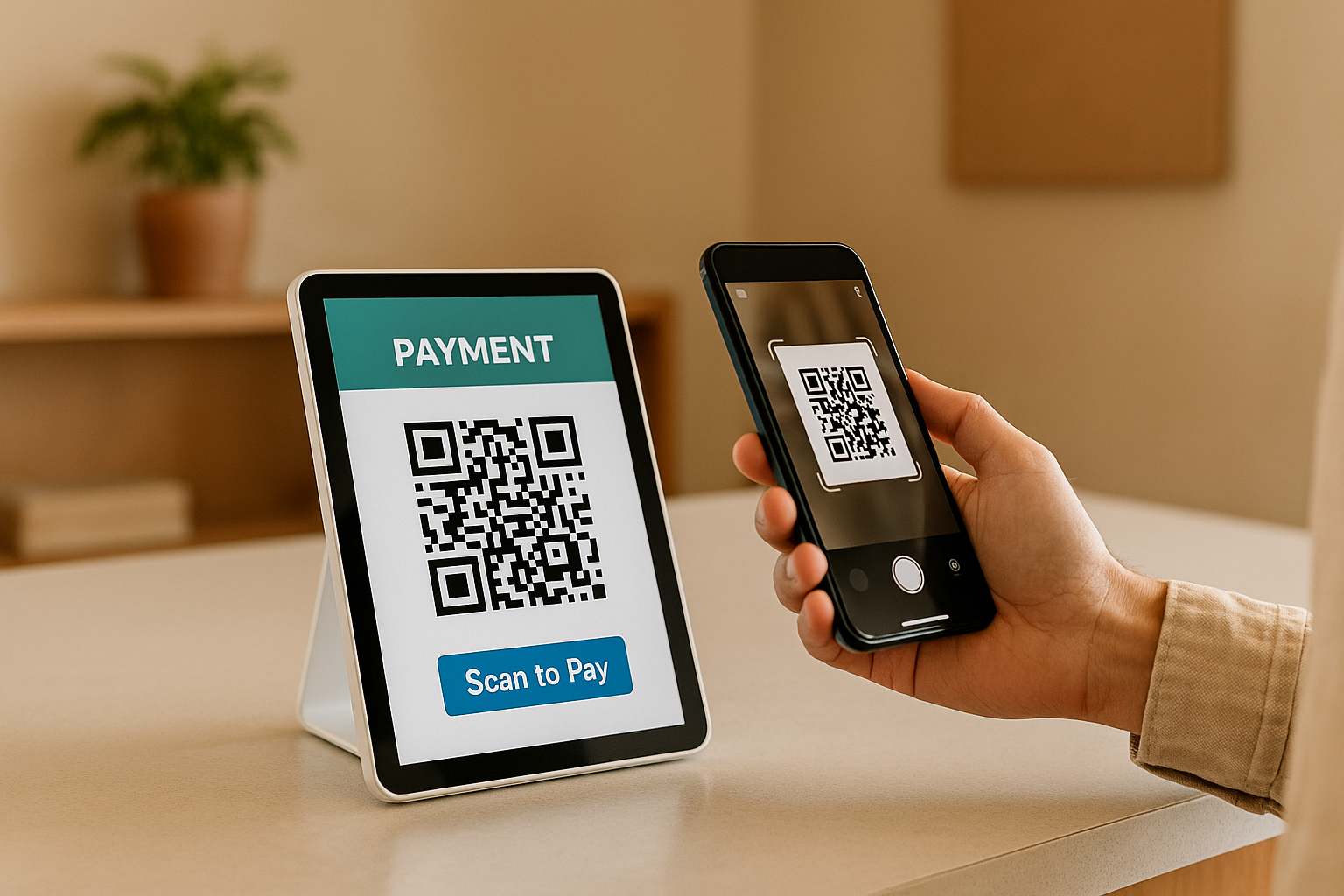Want to accept QR code payments securely and legally? Here’s what you need to know:
QR code payments are growing fast in the U.S., but setting up a compliant system isn’t as simple as displaying a code. You must follow strict security standards like PCI DSS and technical frameworks like EMVCo QR Code Specifications to protect customer data, prevent fraud, and avoid fines.
Key Compliance Steps:
- PCI DSS: Secure all cardholder data with encryption, firewalls, and access controls. Complete required validation (SAQ or ROC) based on transaction volume.
- EMVCo Standards: Ensure QR codes work across devices and payment networks. Use dynamic QR codes to reduce fraud risks.
- Data Security: Encrypt data in transit (TLS 1.2+) and at rest (AES 256-bit). Use tokenization and multi-factor authentication.
- Fraud Prevention: Monitor transactions in real-time, use behavioral analytics, and train staff to spot tampered QR codes.
- Daily Operations: Reconcile transactions, manage disputes, and store detailed transaction logs for 18 months.
Why it matters: Following these steps protects your business from data breaches, fraud, and regulatory penalties while giving customers a secure and reliable payment experience.
Core Compliance Requirements for QR Code Payment Systems
Ensuring compliance in QR code payment systems is crucial for protecting both businesses and customers while maintaining smooth operations.
The Payment Card Industry Data Security Standard (PCI DSS) is the backbone of secure payment processing, and QR code payment systems must adhere to its rigorous guidelines. Merchants accepting credit cards are required to handle and store data securely across 12 security domains, with annual validation based on their merchant level, which is determined by yearly transaction volumes:
- Level 1: Over 6 million transactions annually; requires a Report on Compliance (ROC) and quarterly scans.
- Level 2: Between 1 and 6 million transactions; needs a Self-Assessment Questionnaire (SAQ) or an ROC, along with quarterly scans.
- Level 3: Between 20,000 and 1 million online transactions or under 1 million total transactions; mandates an SAQ and quarterly scans.
- Level 4: Fewer than 20,000 online transactions or up to 1 million total transactions; requires an SAQ and quarterly scans.
The type of SAQ you’ll complete depends on how your QR code system manages cardholder data. For example, if your QR codes redirect users to a secure payment page hosted by a PCI-compliant third-party provider, you may qualify for SAQ A, which has the least compliance burden.
PCI DSS compliance is built on six key objectives that directly impact QR payments:
- Building and maintaining secure networks: This involves installing firewalls and applying secure configurations to all systems.
- Protecting account data: Requires encrypting stored cardholder data and securing its transmission using protocols like TLS.
- Maintaining vulnerability management: Includes updating anti-virus software and applying patches promptly.
- Strong access controls: Restricts access to cardholder data based on business needs, assigns unique user IDs, and enforces multi-factor authentication for admin access.
- Regular monitoring and testing: Involves daily log reviews, tracking network access, and conducting quarterly vulnerability scans.
- Information security policies: These policies must cover annual reviews, employee training, and incident management procedures.
With PCI DSS v4.0 Phase 2 coming into effect in March 2025, merchants need to prepare for stricter requirements, such as advanced firewall configurations, improved encryption protocols, enhanced file monitoring, and upgraded logging systems.
Next, let’s examine the EMVCo QR Code Specifications, which ensure seamless technical and operational standards for payment platforms.
EMVCo QR Code Specifications

The EMVCo QR Code Specifications establish a technical framework that ensures QR payment codes work seamlessly across various payment networks and devices. These standards are crucial for secure and interoperable payment processing.
There are two primary modes for QR code payments:
- Consumer-Presented Mode (CPM): Customers display QR codes on their mobile devices for merchants to scan.
- Merchant-Presented Mode (MPM): Merchants display QR codes for customers to scan with their payment apps.
Both modes must comply with EMVCo standards to ensure compatibility across diverse payment systems and regions. These specifications include features like data integrity checks, standardized encryption, and fraud prevention mechanisms to safeguard transactions for both merchants and consumers.
EMVCo standards also define how QR codes should structure payment data, such as merchant identification, transaction amounts, currency codes, and other parameters. This consistency allows payment apps from different providers to process QR payments without errors, reducing transaction failures and improving the customer experience.
For U.S. merchants, EMVCo compliance is particularly important as the ASC X9 unified QR code standard currently in development is expected to incorporate these specifications. This standard aims to align with instant payment systems like FedNow and RTP, making EMVCo compliance a forward-thinking move [2].
Beyond technical standards, secure QR code generation plays a critical role in reducing fraud risks.
Secure QR Code Generation and Display
Dynamic QR codes offer enhanced security by generating unique codes for each transaction. These codes include specific details like transaction amounts, timestamps, and merchant identifiers. Unlike static QR codes, which contain fixed information, dynamic codes expire after use or within a set time frame, significantly lowering the risk of fraud.
To further secure QR code generation, incorporate cryptographic measures like digital signatures, encryption, and randomization to prevent tampering or predictability. Regular inspections of physical QR code displays are also essential to detect tampering, overlay attacks, or unauthorized replacements.
Code validation is another critical step. Each QR code should be checked to ensure it contains accurate merchant information, transaction details, and security parameters. For example, embedded URLs should direct users to legitimate payment processors, and all data fields must be properly formatted.
If your business relies on third-party QR code solutions, it’s important to ensure the provider follows strict security protocols. These should include secure API communications, encrypted data storage, and regular security audits. Providers should also offer real-time monitoring to detect and prevent fraudulent QR code generation attempts.
Secured Payments offers integrated QR code solutions that align with both PCI DSS and EMVCo standards, ensuring a secure and efficient payment process.
Data Security and Fraud Prevention in QR Payments
To ensure QR payment systems meet top-tier security standards, they align with PCI DSS and EMVCo guidelines. Protecting customer data and preventing fraud in these systems requires a multi-layered defense strategy that works cohesively to safeguard sensitive information.
Data Encryption in Transit and at Rest
Encryption is a cornerstone of QR payment security. All payment data should be encrypted using TLS 1.2 or higher during transmission and AES 256-bit encryption when stored. This ensures that even if data is intercepted or accessed, it remains unreadable.
For data at rest – like customer credentials, transaction histories, or merchant account details – AES 256-bit encryption provides robust protection. To further secure this data, encryption keys should be managed with care. Store keys separately, rotate them regularly, and use Hardware Security Modules (HSMs) to prevent tampering.
In addition to encryption, other tools like tokenization and authentication add extra layers of security to QR transactions.
Tokenization and Strong Customer Authentication
Tokenization replaces sensitive payment information with unique, randomly generated tokens that cannot be traced back to the original data. For instance, when a customer scans a QR code to pay, their actual card details are converted into a token. Even if intercepted, this token is useless to fraudsters.
Actual credentials should always be stored securely, while tokens are used for processing payments.
Strong Customer Authentication (SCA) adds another layer of protection by requiring multiple forms of verification. This often involves confirming:
- Something the customer knows (e.g., a PIN)
- Something the customer has (e.g., their smartphone)
- Something the customer is (e.g., biometric data like a fingerprint)
Biometric verification methods – such as fingerprint scans, facial recognition, or voice authentication – are particularly effective. These should be activated for higher-risk scenarios, such as transactions with unusual spending patterns or payments made from unfamiliar devices or locations.
Real-Time Fraud Detection and Monitoring
While secure data handling is critical, continuous monitoring is equally important for preventing fraud. Real-time systems can track transaction frequency, compare geolocation data to typical patterns, and analyze device fingerprints to detect anomalies.
Machine learning plays a key role here. By studying historical transaction data, these algorithms learn what constitutes normal customer behavior and can flag deviations, such as unexpected transaction amounts or payments at odd hours.
When suspicious activity is detected, real-time monitoring systems should trigger immediate alerts, allowing for quick intervention. Notifications can be configured to ensure that potentially fraudulent transactions are reviewed before they’re processed.
Behavioral analytics add another layer of fraud prevention. Legitimate users tend to follow predictable patterns when scanning QR codes or entering credentials. Fraudsters, on the other hand, may display irregular behaviors – like multiple failed login attempts or rapid, repeated transactions – that warrant closer scrutiny.
Secured Payments’ fraud detection tools integrate these capabilities, offering merchants a comprehensive monitoring system. This helps businesses identify and stop fraudulent QR transactions before they can harm operations or erode customer trust.
sbb-itb-8c45743
Daily Operations and Reconciliation for QR Payments
Daily operations play a crucial role in maintaining the integrity of QR payment systems. By implementing consistent practices, businesses can ensure accurate records and stay operationally compliant.
Daily Reconciliation and Settlement Accuracy
To keep QR payment records accurate, start by matching the daily totals from your payment processor with the records in your POS system. Generate specific reconciliation reports dedicated to QR transactions to streamline the process.
Keep in mind that settlement times for QR payments can vary. For instance, some digital wallet payments settle on the same day, while others may take 2-3 business days. Always display amounts in U.S. dollars (e.g., $1,234.56). For international transactions, ensure that foreign currency payments are converted using the correct exchange rates at the appropriate times. Any currency conversion fees should be documented separately to maintain clear and accurate profit margins.
Develop a daily reconciliation checklist to simplify the process. This should include:
- Verifying the total number of transactions
- Confirming total dollar amounts
- Checking fee calculations
- Identifying and addressing any erroneous transactions
If you encounter failed QR transactions, investigate them immediately. There’s a chance customers may have been charged even though the payment wasn’t confirmed on your end. Once reconciliations are complete, handle any disputes or inconsistencies without delay.
Dispute and Chargeback Management
Accurate and detailed records are essential for resolving disputes efficiently. QR payment disputes require specific documentation, as customers initiate these payments by scanning a code. Merchants need to prove that the QR code used was legitimate and that the transaction was authorized.
Maintain transaction logs that include:
- Timestamps
- QR code IDs
- Device details
- Geolocation data
Store these logs for at least 18 months to ensure compliance and facilitate dispute resolution.
The response timeframes for QR payment chargebacks are usually the same as those for traditional card payments – 7 to 10 days for an initial response. However, gathering evidence for QR-related disputes can take longer due to the involvement of multiple systems. Use automated alerts to stay on top of disputes and respond promptly.
For stronger protection against disputes, log details for every QR code generated, including its creation time, active duration, and usage type. Single-use QR codes are particularly effective, as they provide clear proof that the specific transaction was intentional.
Preventing chargebacks starts with clear communication. Display your business name prominently near QR codes to ensure customers recognize charges on their statements. Include transaction amounts and merchant information in payment confirmations to avoid confusion. If possible, keep video evidence of QR payment areas. This can be invaluable in disputes, especially for high-value transactions, as it shows customers voluntarily scanning the code.
Employee Training and Device Security
Operational security hinges on well-trained staff and secure devices. Employees should be able to recognize fraudulent behavior, such as customers who seem unsure about the payment process, multiple failed scan attempts, or requests to alter QR codes. In some cases, fraudsters may attempt to replace legitimate QR codes with malicious ones, so staff must know how to verify their authenticity.
Make it a habit to inspect QR code displays daily to prevent tampering. For static QR codes, use tamper-evident materials. Digital displays should be positioned where staff can monitor them easily.
Device security protocols are equally important. These include:
- Keeping software updated regularly
- Using secure Wi-Fi connections
- Implementing proper logout procedures
- Enabling automatic screen locks on devices used to generate QR codes
- Requiring authentication for access to payment apps
Establish clear incident reporting procedures so employees know what to do if they suspect fraud. This should involve disabling compromised QR codes immediately, documenting the incident thoroughly, and notifying management. Prompt action can prevent further fraudulent activity.
Stay ahead of emerging fraud techniques by regularly updating employee training. Social engineering attacks targeting QR payments are evolving quickly, making ongoing education essential.
For additional support, companies like Secured Payments offer training resources and security tools. Their integrated monitoring systems can alert staff to unusual payment patterns in real time, helping businesses address issues before they escalate.
Testing and Compliance Validation
Once your daily operations are running smoothly, it’s time to thoroughly test and confirm your system’s compliance. This step involves diving into detailed vendor and app documentation to ensure everything aligns with required standards.
Vendor and App Documentation
Having complete vendor documentation is crucial. It allows merchants to verify whether their vendors meet the necessary compliance standards. Start by examining the EMVCo QR Code Specifications for both Consumer-Presented Mode and Merchant-Presented Mode. This will help you confirm that your vendor’s solution aligns with global standards for data formatting and interoperability.
Make sure to gather proof that your vendors are using EMVCo’s self-evaluation tools and are adhering to the QR Code Specifications. If your business uses the EMV QR Payment Mark or EMV QR Scan symbols, obtain the exact reproduction requirements to ensure proper use of these logos.
For a more seamless process, merchants can utilize Secured Payments’ integrated systems, which come equipped with compliance monitoring and vendor management tools. Conducting thorough tests on vendor documentation ensures every part of your QR payment setup stays secure and compliant.
Conclusion
Following the steps outlined in this QR code payment compliance checklist can help ensure your payment system is both secure and efficient. Adhering to PCI DSS standards not only minimizes the risk of data breaches but also protects your business from costly fines, bad press, and the potential loss of customers.
EMVCo standards add another layer of reliability by enabling global payment interoperability. With a single QR code, you can accept multiple payment types, including card-based and account-based transactions. This streamlined approach speeds up checkout times and enhances the overall customer experience.
For your customers, compliance means better protection of their sensitive data. Since account information is never directly handled by staff, the risk of identity theft is greatly reduced. This level of security fosters trust, making customers more likely to return and do business with you again. Together, these measures make your QR payment system more secure and dependable.
Incorporating these practices into your daily operations strengthens your payment process, creating a system that’s not only trustworthy but also efficient. A well-maintained compliance routine reinforces customer confidence and loyalty.
FAQs
What’s the difference between Consumer-Presented Mode and Merchant-Presented Mode in QR code payments, and how does it affect compliance?
The main difference between Consumer-Presented Mode (CPM) and Merchant-Presented Mode (MPM) lies in who creates the QR code. With CPM, the customer generates a QR code on their mobile device, which the merchant scans. In MPM, the merchant generates the QR code, and the customer scans it.
This difference has a notable impact on compliance. CPM involves customer-generated codes, which can vary significantly. These variations complicate standardization and system integration, increasing the potential for errors. To address this, additional security measures are often necessary to ensure compliance. In contrast, MPM relies on merchant-generated codes, which are generally more uniform. This consistency makes standardization easier, simplifies compliance, and reduces operational challenges.
In short, MPM offers a simpler path for managing compliance, while CPM requires more robust protocols to ensure secure and reliable transactions.
What steps can merchants take to ensure their QR code payment systems comply with PCI DSS v4.0 Phase 2 requirements?
To meet the requirements of PCI DSS v4.0 Phase 2, merchants need to focus on implementing strong encryption and reliable security protocols within their QR code payment systems. It’s also essential to incorporate multi-factor authentication (MFA) where necessary and ensure that payment data is transmitted securely to block any unauthorized access.
Take the time to review and update your self-assessment questionnaires (SAQs) and security practices to reflect the latest standards. Conduct regular system audits, document all compliance efforts, and adopt advanced authentication measures to align with the updated guidelines. By staying ahead with these actions, you can keep your payment systems secure and in compliance with the latest regulations.
How can merchants effectively resolve QR code payment disputes while staying compliant with record-keeping requirements?
When dealing with QR code payment disputes, acting swiftly and methodically is crucial. Start by documenting the dispute claim in detail, gathering all relevant transaction information, and compiling supporting evidence such as receipts or transaction records. Timely responses paired with precise documentation are essential for resolving disputes effectively.
Additionally, it’s important to keep comprehensive records of all communications, transaction details, and evidence tied to the dispute. This approach not only strengthens your defense against potential chargebacks but also ensures you remain in line with U.S. regulatory requirements. Staying organized and proactive can make a significant difference in achieving better outcomes during the resolution process.




